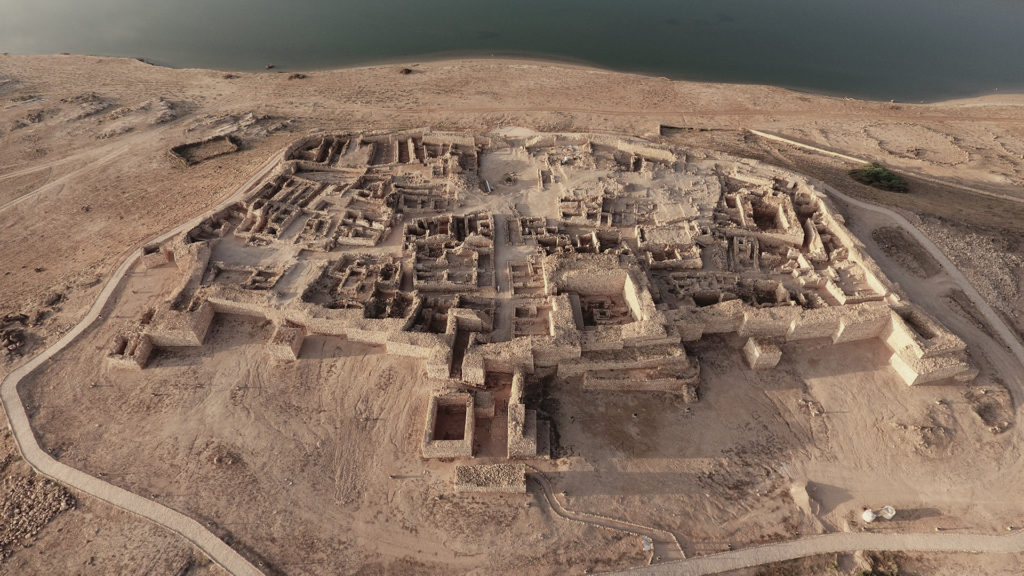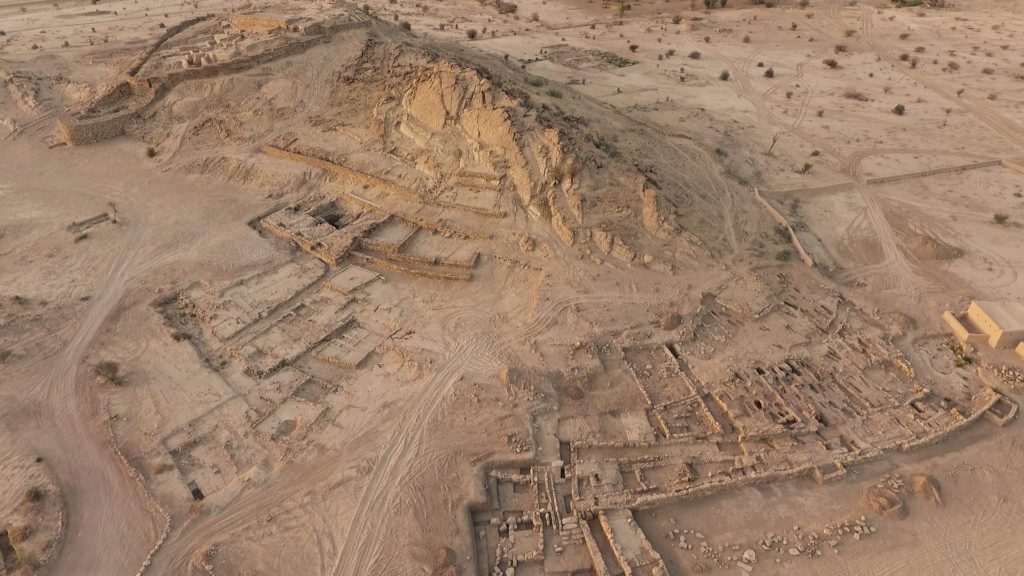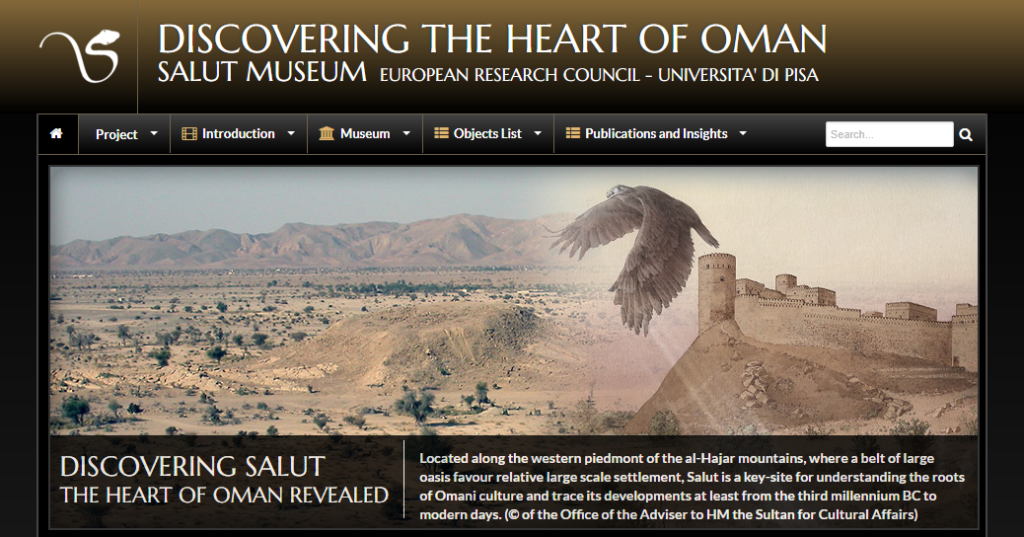ITALIAN MISSION TO OMAN
An archaeological mission of the University of Pisa, headed by Alessandra Avanzini, worked from 1996 to the end of 2019 in Oman. Sumhuram and Salūt are the two main sites where the Italian mission to Oman (IMTO) of Pisa carried out the archaeological and restoration work. Many scholars from Italy and other countries (Russia, United Kingdom, India) participated in the mission in this long period. Beside the scientific work IMTO organized archaeological parks for Sumhuram, Salūt, and Wubar.
The whole IMTO project has been carried out thanks to the invaluable support of the Office of His Excellency Abdulaziz Al-Rowas, the Advisor to His Majesty the Sultan for Cultural Affairs.
SUMHURAM

IMTO’s discoveries in Sumhuram are widely acknowledged as a ground breaking result that changed the perspective in the studies of the long-distance traffic between the Mediterranean and India. The port of Sumhuram, in the Dhofar Governorate, was involved into international trade by sea. The great historical importance of this area was due to trade of a precious product: frankincense. Pottery imported from India, Hellenistic pottery; coins bear witness to a possible date of the foundation of a first settlement at the end of the third century BC before the notable development of trade by sea in the Roman period. Sumhuram was not definitively abandoned until sometime at the end of the 4th century-beginning 5th century AD. Therefore, the port of Sumhuram was active for about eight centuries. In this long history several contacts have been tied between Sumhuram and many faraway countries, in particular with India.
The city urban plan is regular, streets follow an orthogonal matrix, large spaces are geometrically designed. The buildings were surely not erected at random. Sumhuram was a small walled city, the useful internal surface area is less than ten thousand square meter. But it was a very well-organized and lively city with temples, private and public buildings, a vast storehouse district, impressive fortifications, and busy artisan quarters within the city walls, and fertile fields and orchards outside the city limits. Workshops for the metal working are attested in Sumhuram. Furnaces for producing iron and bronze objects are located in the area around the market square. In the city there are ovens for baking bread; kilns for making building-plaster and a pottery kiln (the first pottery kiln found in South Arabia). In Sumhuram purple-dyed cloths were produced.
The city walls have been completely restored. The city walls with their offsets built at regular intervals are really impressive. Excavations within the city have highlighted streets, squares, buildings. The walls that flank the streets have an original elevation of more than two meters. It is now possible to walk in ancient streets. In 2000 UNESCO entered Sumhuram into the World Heritage List together with other sites in Dhofar connected with the trade of frankincense.
SALŪT

The excavations in Salūt have contributed to a general rethink of the Iron Age in the eastern Arabia. The history of the area of Salūt near Bisya in the Ad-Dakhiliya Governorate was very long. Bronze age towers and tombs, bear testimony to history of Salūt as part of the Magan culture. North-west from the main site, a few hundred metres away, there is an imposing tower from the Early Bronze age (end of the 4th millennium BC). The materials dug by the excavations of the tower bear witness to imports and contacts with the Indus valley civilization. Salūt reached its maximum splendour during the Iron age (1300 BC-300 BC).
Salūt extends over a hill (Husn Salūt ‘the castle of Salūt’) and the surrounding plain (Qaryat Salūt ‘the village of Salūt’). Husn Salūt was built on the most prominent point of an elongated rocky outcrop that emerges from the plain. A massive wall encircles the whole summit of the hill; an enormous platform in raw bricks characterizes the upper part of Salūt. The objects found during the excavation of the platform suggest that it was a place of worship, of meeting. For example, bronze snakes, a large cauldron are objects that can confidently be connected to a cultic, ritual significance.
Qaryat Salūt is an extensive settlement characterized by a complex systems of terraces located along the slopes of the hill, used as orchards; the dwelling area is located in the plain. A wall fortification with a monumental entrance protected the settlement. The great planning capacity (the drainage system, the road network, the functional division of the settlement) indicates a well-organized society.
Some tombs (2nd /1st century BC- 1st century AD) have been excavated in the plain. A series of imported objects (glass bowls of Roman-Levantine production, Parthian glazed vessels, bronze drinking sets related to banquets) together with items of local production have been found.
Restoration work was carried out at a pace with the excavations. Salūt is now a prominent land mark in the area, which can be safely visited and understood by visitors.
SALUT VIRTUAL MUSEUM

WATCH THE VIDEOS
More about the restoration works can be found at www.stefanobizzarri.it/archaeology website. In addition to the restoration activities, the architect Stefano Bizzarri was also responsible for the dissemination of the sites. Two introductory videos to the two settlements can be watched below.
LINKS AND DOWNLOADS
The archeology specialists of the Arabian Peninsula find here all the preliminary reports of the excavation campaigns in Sumhuram and in Salūt. From this website a link also refers to the virtual museum of Salūt.